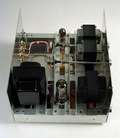 |
|
Headphone Amplifier |
 |
This project was born when I realized that quality of the sound coming from my headphone (an old but excellent AKG 240, 600 ohm) plugged into headphone output of my computer (I use headphones when burning CD's from vinyl LP's - ah, vinyl….unbeatable, did You ever tried to listen to vinyl in your car?) was worst than that coming from burnt CD through headphones plugged into the amplifier.
It is clear that the digital amplifier of my Mac, really not bad, is not as good as any analog gear.
Then a new amplifier, a tube gear, of course.
|
The Amplifier
|
|
 |
Headphones do not require a lot of power: AKG 240 features 88dB and 200 mW maximum power; this means that as much as 50 mW are enough to get me deaf (really I'm used to listen at very low level).
So no need for complex schematic, power tubes and so on.
After some surfing (very interesting www.audiodesignguide.com, the well known web site of Andrea Ciuffoli, and headwize2.powerpill.org, a whole web site for headphones) I designed the amplifier and the power supply.
|
Not an esoteric one, as You see, but some well known "tricks": tube supply with inductor filter, fixed bias, DC heating and heater a little bit positive vs cathode.
I chose 6H30 because it is a current production for military use, then easy to find and low price, and with a very good reputation for sonic quality.
Operating point is 110 V, 15 mA that is good for the characteristics of the tube and of output transformer.
You can find the specs of 6H30 in Steve Bench's web site, members.aol.com/sbench101, another site very rich of interesting information, schematics, suggestions.
At this operating point mu is about 15 and Rp about 1600 ohm, that suggest the Sowter 8988 as output transformer (www.sowter.co.uk ).
Sowter 8988 has 4 secondary windings which give 40, 150, 300 or 600 ohm output impedance reflecting 10 kohm to the tube, perfect for 6H30.
Secondary windings must be configured for the load You need, it is not possible to have an impedance selector.
The input selector is not necessary and if You can, do not use it; I couldn't so it is there.
|
The Power Supply
|
|
 |
With any amplifier, either a semiconductor or a tube one, power supply is responsible of the quality of sound at least as the amplifier itself.
For a tube amplifier in my opinion a tube rectifier with inductor filter is the best; 5Y3 fits with the limited corrent required and is very silent.
Heater current is 0.9 A, trim the series resistor to have 6.3 V.
Each tube has its own bias regulation.
|
Adjustment
|
|
After completing the assembly, take a day off and check again everything; before plugging the tubes plug the power cable and check for voltages and …. Smoke!!!
Turn the bias trimmers to have -10V on grid pins. |
|
Switch off AC, plug 5Y3, switch on AC: You must have about 125 V on the capacitor after the inductor. |
 |
Switch off AC, discharge the capacitors with a 10 k resistor then plug 6H30 (be sure that the two output transformers are not connected on the capacitor side).
Connect a DC current meter between one output transformer and the positive of one capacitor (be careful: the meter is at 110 - 115 volts) and switch on AC.
The reading must be about zero, turn the trimmer to read 15 mA. |
|
Switch off AC, connect the output transformer to the adjusted triode, then repeat the procedure on the other channel.
Swith on, let it burn a couple of hours then check again operating points: You can measure votage across 1.5 k resistors in the power supply.
Except for output transformers, do not waste money in very special components, hand crafted by the angels in heaven, silver platinum plated wires, and things like this; instead, be accurate in construction and soldering and wiring.
|
|
|
|